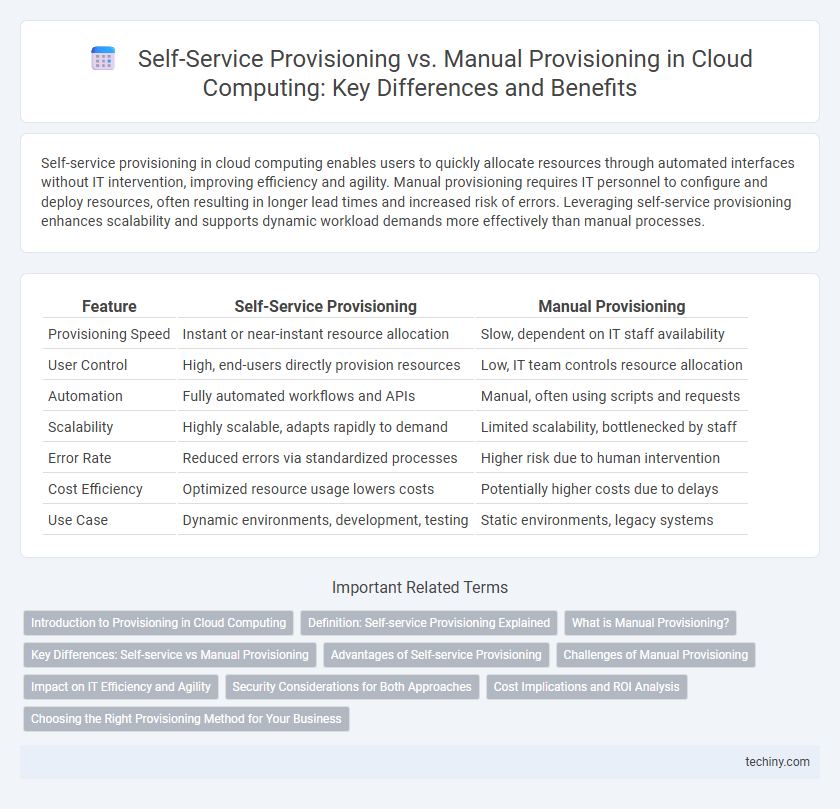Self-service provisioning in cloud computing enables users to quickly allocate resources through automated interfaces without IT intervention, improving efficiency and agility. Manual provisioning requires IT personnel to configure and deploy resources, often resulting in longer lead times and increased risk of errors. Leveraging self-service provisioning enhances scalability and supports dynamic workload demands more effectively than manual processes.
Table of Comparison
| Feature | Self-Service Provisioning | Manual Provisioning |
|---|---|---|
| Provisioning Speed | Instant or near-instant resource allocation | Slow, dependent on IT staff availability |
| User Control | High, end-users directly provision resources | Low, IT team controls resource allocation |
| Automation | Fully automated workflows and APIs | Manual, often using scripts and requests |
| Scalability | Highly scalable, adapts rapidly to demand | Limited scalability, bottlenecked by staff |
| Error Rate | Reduced errors via standardized processes | Higher risk due to human intervention |
| Cost Efficiency | Optimized resource usage lowers costs | Potentially higher costs due to delays |
| Use Case | Dynamic environments, development, testing | Static environments, legacy systems |
Introduction to Provisioning in Cloud Computing
Self-service provisioning in cloud computing enables users to automatically allocate resources through an intuitive interface, accelerating deployment times and enhancing scalability. Manual provisioning requires IT administrators to configure hardware and software resources, often causing delays and potential errors. Efficient provisioning is essential for optimizing cloud resource utilization and maintaining operational agility.
Definition: Self-service Provisioning Explained
Self-service provisioning in cloud computing enables users to automatically configure and deploy resources through a web-based portal or API without IT intervention, significantly speeding up access to computing power, storage, and applications. This contrasts with manual provisioning, where IT administrators manually allocate and configure resources, often resulting in longer wait times and higher risk of errors. By leveraging self-service portals, organizations achieve greater agility, scalability, and operational efficiency in managing cloud environments.
What is Manual Provisioning?
Manual provisioning in cloud computing refers to the process where IT administrators manually allocate resources, configure servers, and set up applications without automated tools or interfaces. This method often involves direct interaction with hardware or software through command-line instructions or GUI panels, resulting in longer deployment times and higher chances of human error. Manual provisioning contrasts with self-service models by relying heavily on human intervention, limiting scalability and agility in cloud environments.
Key Differences: Self-service vs Manual Provisioning
Self-service provisioning in cloud computing enables users to independently allocate and manage resources through automated portals, reducing dependency on IT staff and accelerating deployment times. Manual provisioning requires IT administrators to configure and allocate resources, often leading to longer wait times and potential for human error. Key differences include speed, scalability, and user empowerment, with self-service offering dynamic, on-demand resource allocation compared to the static and controlled nature of manual provisioning.
Advantages of Self-service Provisioning
Self-service provisioning in cloud computing enables users to rapidly deploy and manage resources without IT intervention, drastically reducing wait times and improving operational efficiency. It empowers teams with on-demand access to scalable infrastructure, enhancing agility and fostering innovation by allowing immediate response to changing workloads. This approach also minimizes human error and streamlines resource allocation, resulting in cost savings and optimized cloud utilization.
Challenges of Manual Provisioning
Manual provisioning in cloud computing often leads to delays and increased risk of human error due to its repetitive, labor-intensive nature. Challenges include difficulty in scaling resources quickly, inconsistent configurations, and lack of real-time monitoring capabilities. These inefficiencies hinder operational agility and complicate compliance with security policies and service-level agreements.
Impact on IT Efficiency and Agility
Self-service provisioning accelerates IT efficiency by enabling users to deploy resources instantly without direct IT intervention, reducing bottlenecks and freeing IT staff for strategic tasks. Manual provisioning slows operations due to reliance on IT teams for resource allocation, which increases response times and limits organizational agility. Cloud environments leveraging self-service tools empower businesses to adapt quickly to changing demands, optimizing workflow and enhancing competitive advantage.
Security Considerations for Both Approaches
Self-service provisioning in cloud computing enhances operational agility but introduces security risks such as unauthorized access and misconfigurations due to user mismanagement. Manual provisioning offers tighter control and oversight, reducing vulnerabilities but often results in slower deployment and potential for human error. Implementing robust access controls, continuous monitoring, and automated compliance checks is critical to mitigating security risks in both approaches.
Cost Implications and ROI Analysis
Self-service provisioning in cloud computing significantly reduces operational costs by automating resource allocation, minimizing human intervention, and accelerating deployment times, leading to lower labor expenses and faster time-to-value. In contrast, manual provisioning incurs higher personnel costs and slower scalability, which can delay project timelines and reduce overall ROI. ROI analysis typically favors self-service models due to improved resource utilization, decreased downtime, and enhanced agility driving higher financial returns.
Choosing the Right Provisioning Method for Your Business
Self-service provisioning enables businesses to automate resource allocation quickly, reducing dependency on IT staff and accelerating project timelines. Manual provisioning offers greater control and customization, suitable for complex environments requiring detailed configuration and compliance adherence. Evaluating factors such as scale, speed, resource complexity, and operational expertise helps determine the optimal provisioning method to align with business goals and IT capabilities.
Self-service Provisioning vs Manual Provisioning Infographic

 techiny.com
techiny.com